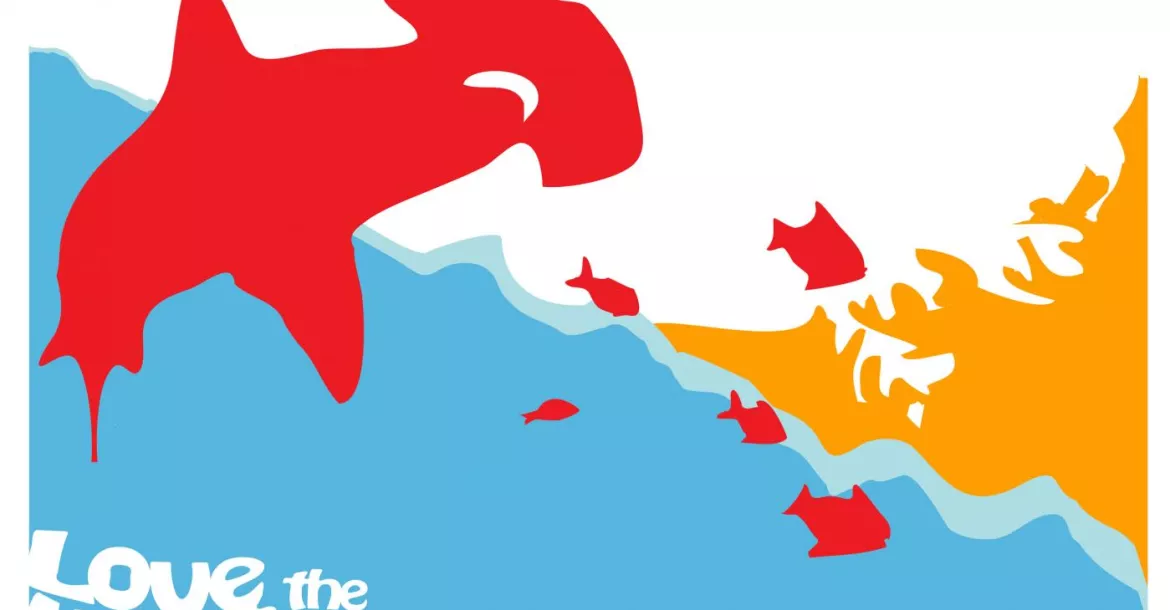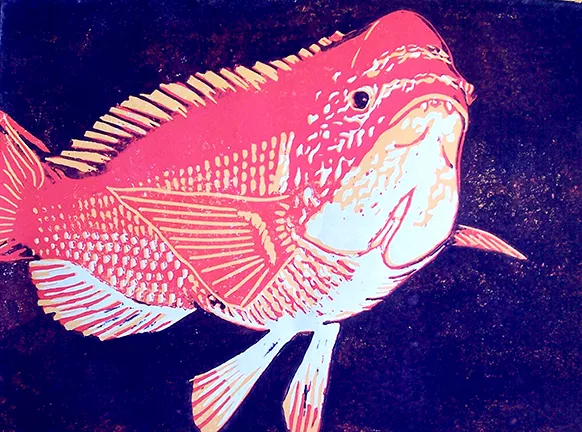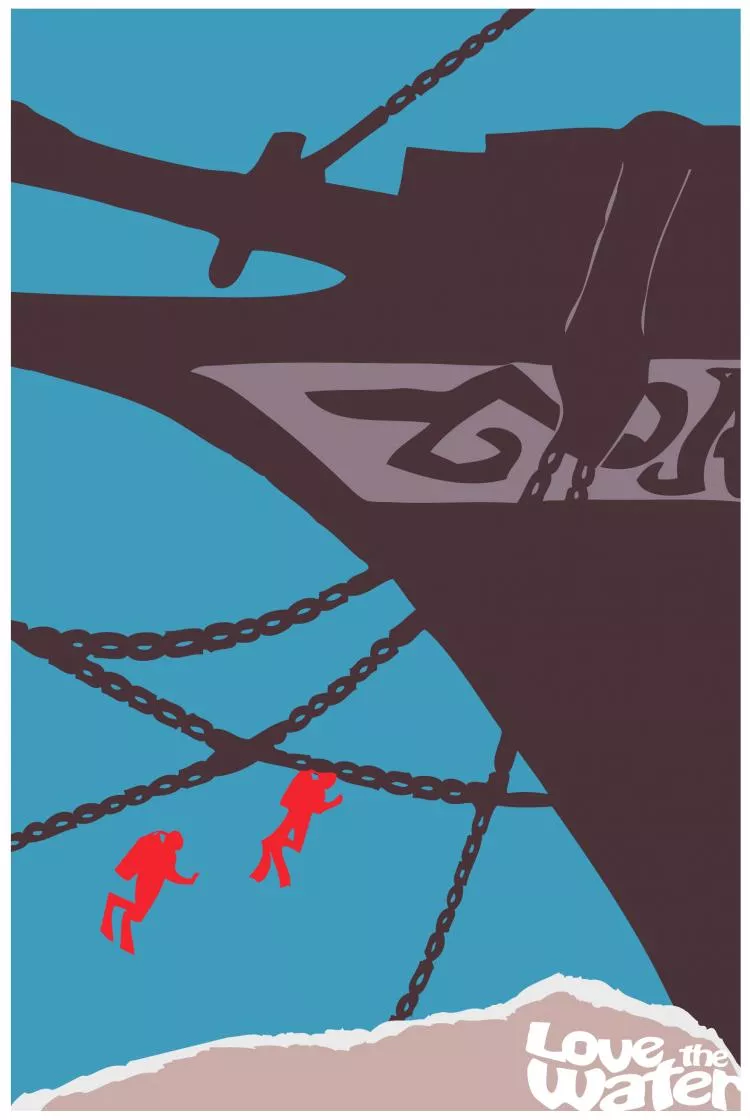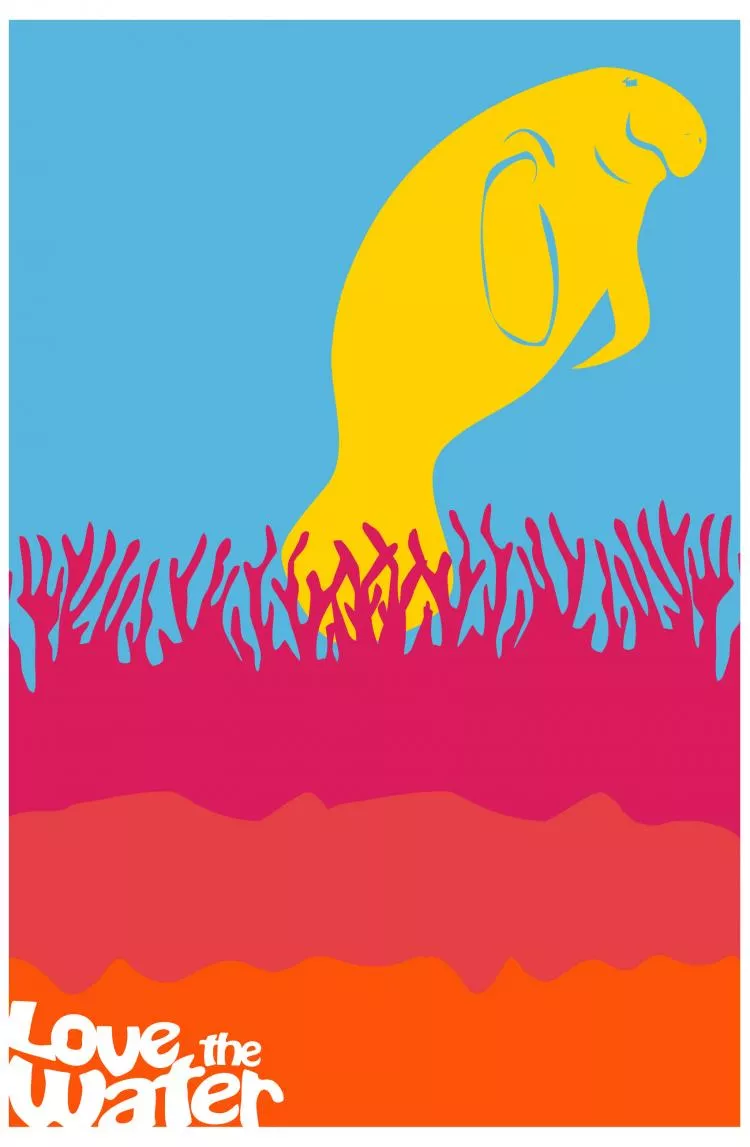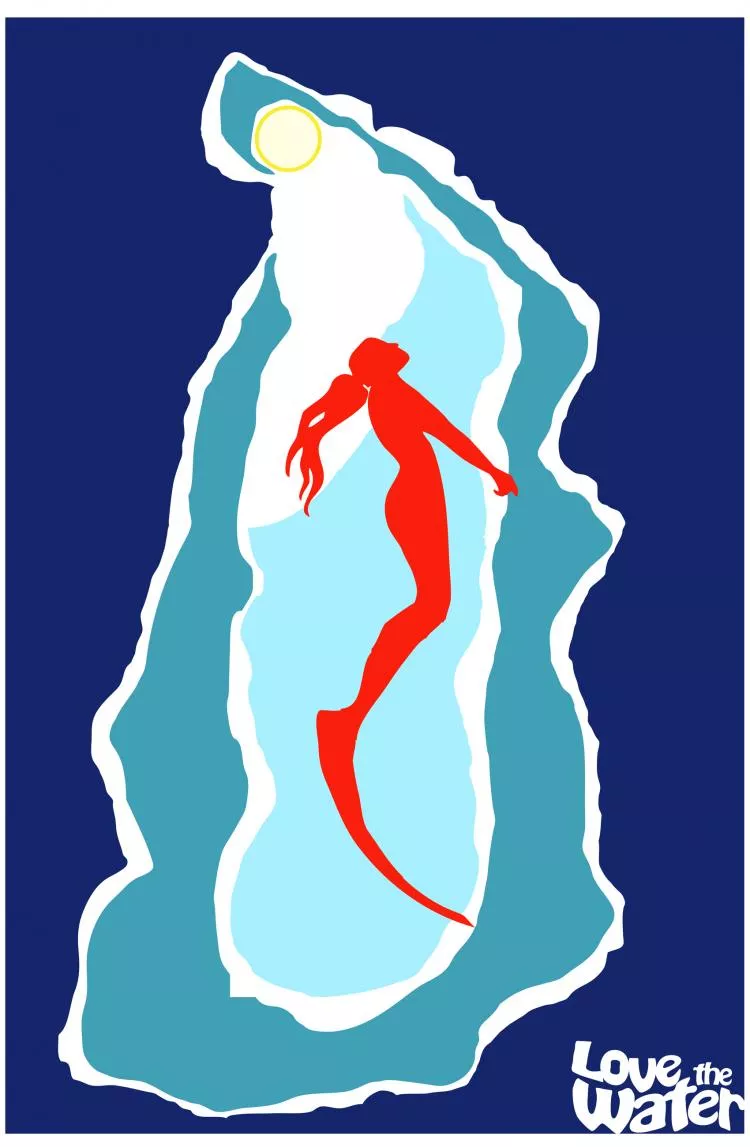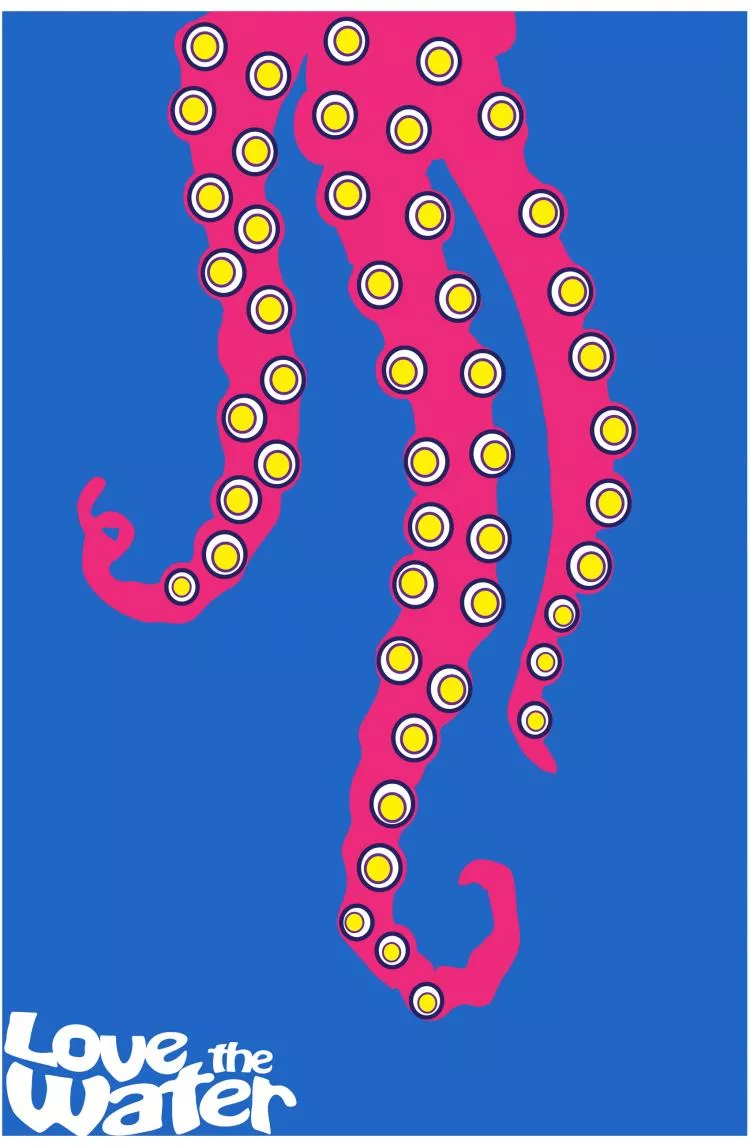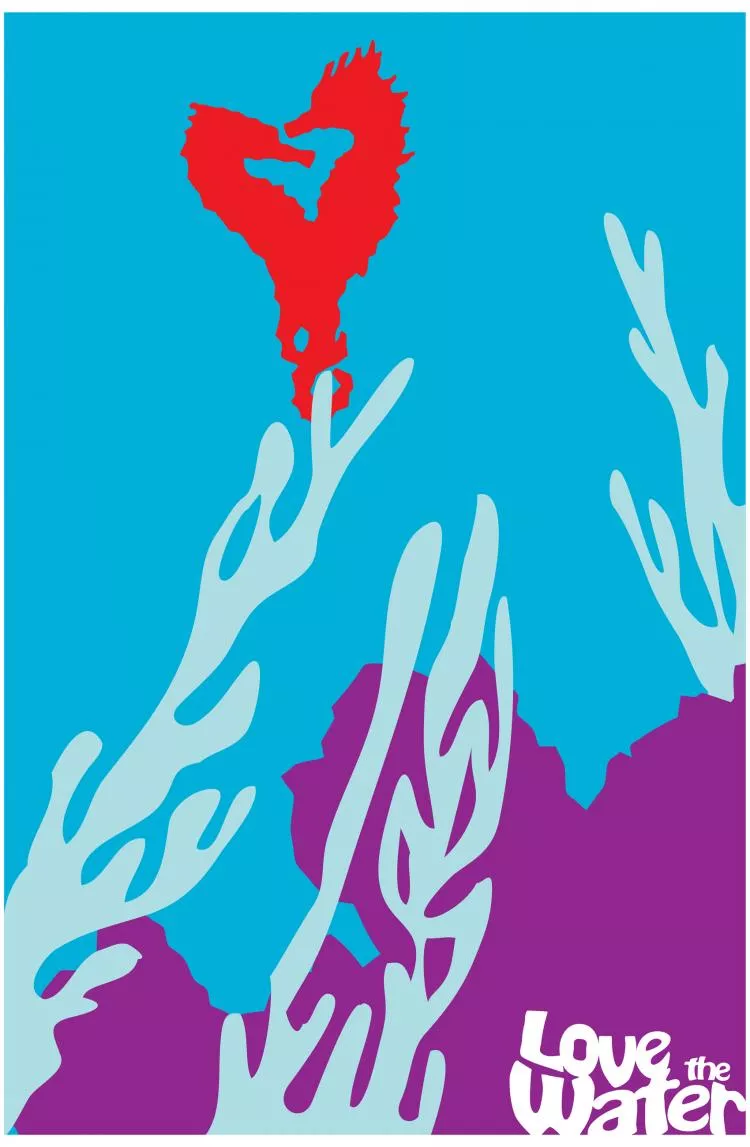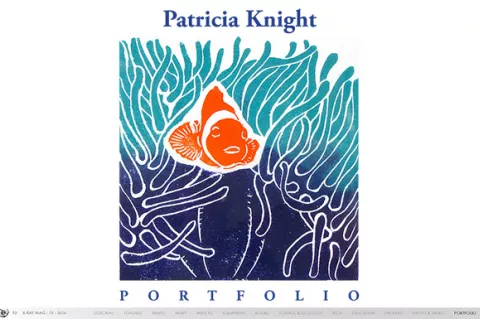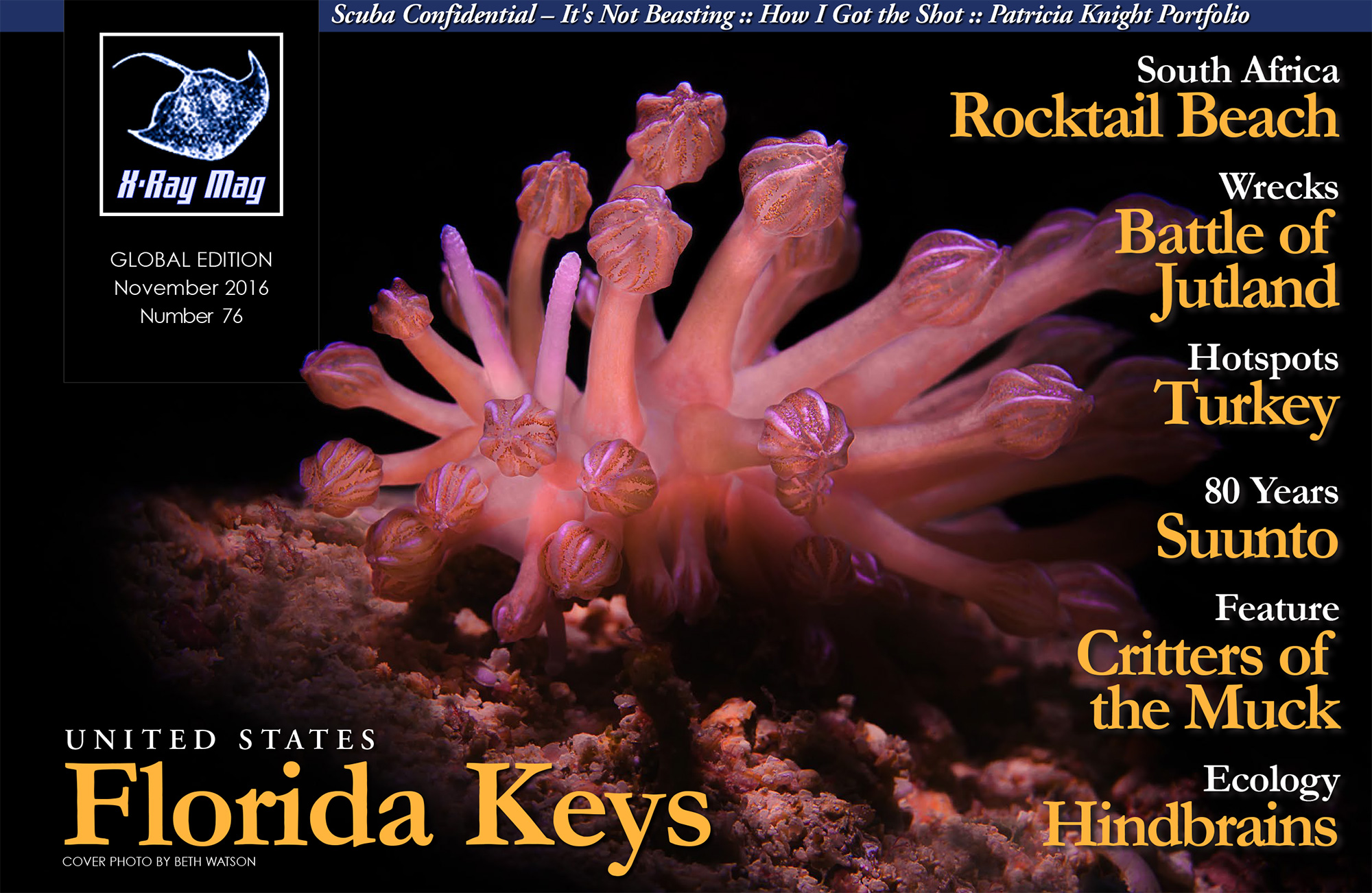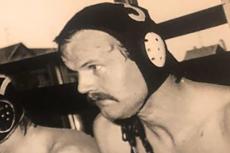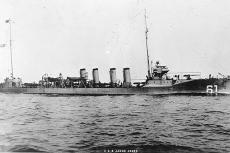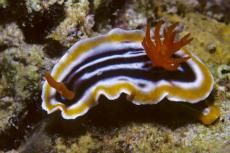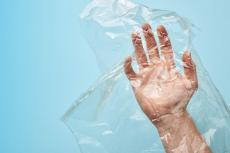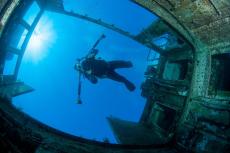
Patricia Knight Portfolio
American artist and scuba diver Patricia Knight creates dynamic papercut graphics and sublime linoleum prints of marine life and divers in underwater scenes, combining age-old printmaking techniques with modern digital graphics. Inspired by the underwater realm, she strives to raise awareness of the ocean’s fragile ecosystem through her art.
Contributed by
X-RAY MAG: Tell us about yourself, your background and how you became an artist.
PK: Growing up in a really small farming town in western New York, we didn’t even have any art classes in school. My parents really indulged me by ordering an art instruction course through the mail, and that’s when I discovered that my fledgling ability to copy figures from the latest magazines could actually be trained into something much more artistic. That was a revelation to me—that art was a skill like anything else—and the more you practiced and studied, the better you would be.
X-RAY MAG: Why marine life and underwater themes? How did you come to these themes and how did you develop your style of printmaking?
PK: In college, I tried out a wide variety of mediums and techniques, but the process of printmaking really captured my attention. Looking back, I think it was that lack of early formal instruction that kept me open to combining such diverse mediums such as carving, paper cutting and vector illustration under the heading of ”printmaking.” I use the same initial planning and thinking process for all my prints, whether they end up as a traditionally or digitally printed output. I know that sounds odd, and I have been told that those two mediums cannot possibly be lumped together, but it works for me. Although I do illustrate other themes, I find myself always coming back to the water. The shapes of water are so fluid and the creatures can be so alien—those flowing lines and unusual shapes are exciting to render in brilliant colors.
X-RAY MAG: What is your artistic method or creative process?
PK: I usually start with a photo that I have taken (or that a dive buddy has shared) for my initial inspiration when developing ideas. At this point, the idea may turn into a free-hand drawing for my monoprints. But my color prints get an extra step.
When I was first developing ideas for my “Love the Water” line (series), I knew I wanted to make the shift to digital art, but I still wanted to work with organic shapes that had some texture and spontaneity, for which vector graphics are not necessarily known. So I make small prototypes from colored paper—ripping and cutting and folding layers and shapes—until I find a perfect combination of color and design.
Once I have a good idea of what the final product should look like, I make the decision to proceed with the print as either a linoleum cut or as a vector design. If it will be a digital print, I scan in my prototype and start redrawing it in Adobe Illustrator. But if it will be a block print, I break out the carving tools.
For multiple color block prints, I usually use a technique called reduction printing in which each color printed is carved away, thereby “reducing” the amount of linoleum left on the plate and ultimately destroying the plate by the end of the print. Sometimes I might use a “jigsaw” technique for color printing in which multiple pieces of linoleum are cut and then inked separately, to be reassembled like a jigsaw puzzle for the final print. My digital art goes to a local specialty art printer, and I work closely with them to make sure each “Love the Water” print is true to my original colors and flawless.
X-RAY MAG: What is your relationship to the underwater world and coral reefs? Are you a scuba diver or snorkeler and how has this influenced your art? In your relationship with reefs and the sea, where have you had your favorite experiences?
PK: For most of my life, I was much more familiar with lakes and mountains than the ocean. But after booking a vacation to Cozumel, my husband (and fellow adventurer) and I decided we needed to get our scuba certification before we went. After doing our final dives in a local quarry and some cold lakes, we were excited to explore more colorful and warmer waters. Cozumel did not disappoint, and we were hooked. I have been trying to capture that brilliant kaleidoscope of colors and shapes ever since, in my artwork.
You get to meet a lot of great people when you are diving, and I was lucky enough to meet up with a young woman who not only had a mermaid fin, but was also willing to model it out in our local reef for an underwater photo shoot. It was so much fun to see the double-takes and wide eyes from both adults and kids alike as we went by with our mermaid sitting regally on our front bow.
X-RAY MAG: What are your thoughts on ocean conservation and coral reef management and how does your artwork relate to these issues?
PK: When we finally made our move to south Florida, we got to really indulge in our diving addiction, but diving that much also enabled me to see the changes that our local reefs are going through—and not always for the better. I also get to hear more stories about the glory days when sharks and other big critters were common sights, fish were so plentiful they practically leapt into the boats, and lobsters as big as toddlers could be found in every coral-covered ledge. Now I see more lionfish than lobsters, and if I ever spot anything shiny, it’s not gold, it’s garbage.
I think it is pretty obvious to most of the public by now that we humans need to make some changes if we want to start to correct the terrible damage that we’ve done to our global waters. But most people have no idea what they could possibly do to help.
I began my “Love the Water” prints so that I could start a dialogue with people about the importance of our oceans. I meet a lot of people during art shows—most of them tourists—and it’s easy to connect with them through my illustrations.
I avoid lectures about conservation, and instead, bring up some interesting facts that might intrigue them: Do they know how much parrotfish play a part in making sand for our beaches? Do they know that the pop-up fences on those same beaches are actually protecting turtle nests? If helping the environment and these wonderful creatures could be as easy as changing the brand of sunscreen you apply so it doesn’t pollute the ocean or picking up just an extra bit of garbage at the beach as you leave, why not try? Love the water!
X-RAY MAG: What is the message or experience you want viewers of your artwork to have or understand?
PK: Printmaking is one of the oldest forms of art. In fact, it was with the invention of the printing technique that information could finally be shared among the masses, and one could argue that it kick-started civilization as we know it. Just because it’s old, doesn’t mean it’s a dead technique, which I hope I showcase when I display both types of printing outputs at the same time. A thousand years later, printmaking is still doing its original job—bringing information to the people.
X-RAY MAG: What are the challenges and/or benefits of being an artist in the world today?
PK: Our current digital age means that I can easily stay in contact with customers and fellow artists around the world. On the other hand, there are the unfortunate consequences of putting your work out there where it can be readily accessible for copying. Today, artists walk a fine line between promoting ourselves and keeping our work our own. It can also be difficult to keep up with social media when all you would like to do is make art, but these are the tools that a working artist must be able to employ to thrive in our world today.
X-RAY MAG: How do people respond to your works? What feedback or insights have you gained from the process of showing your work to various audiences?
PK: Most people understand how a digital print is made. But when I sell at a show, I have learned to bring along a piece of linoleum to carve, and I encourage people to make a print for themselves. They are fascinated by the physical carving and delighted by the final print. It also gives them greater understanding of the physical work that goes into block printing and how it gets made.
Of course, this certainly helps me promote my art. I could be demonstrating to one little girl, but then she will run off with her small print and bring back her parents, who then call over their friends, and before I know it, there is a crowd at my booth that will bring more people over just to see what is going on.
X-RAY MAG: What are your upcoming projects, art courses or events?
PK: I always have the seasonal art shows here in south Florida to get new pieces ready for. But this past summer, the local casino and city worked together to sink a 300ft ship called the Lady Luck only about a mile off shore, as a new artificial reef and diving destination for our area. It’s a gorgeous wreck for diving, and I hope to be a part of some of the promotional activities coming up.
X-RAY MAG: Any final words to share with our readers about yourself and your artwork?
PK: I have been a working artist and an art teacher for most of my adult life, but I still find new things to learn and wonder at and be inspired by. Every day, I hope to pass on that same sense of experimentation and joy to my students. And if my artwork and underwater adventures can also be used to further some knowledge of ocean conservationism—even better. ■
For more information, please visit the artist’s websites at: ArtCatStudio.com and Etsy.com/shop/ArtCatStudio.
I began my 'Love the Water' prints so that I could start a dialogue with people about the importance of our oceans. I meet a lot of people during art shows—most of them tourists—and it’s easy to connect with them through my illustrations.
— Patricia Knight
Published in
-
X-Ray Mag #76
- Læs mere om X-Ray Mag #76
- Log ind for at skrive kommentarer
